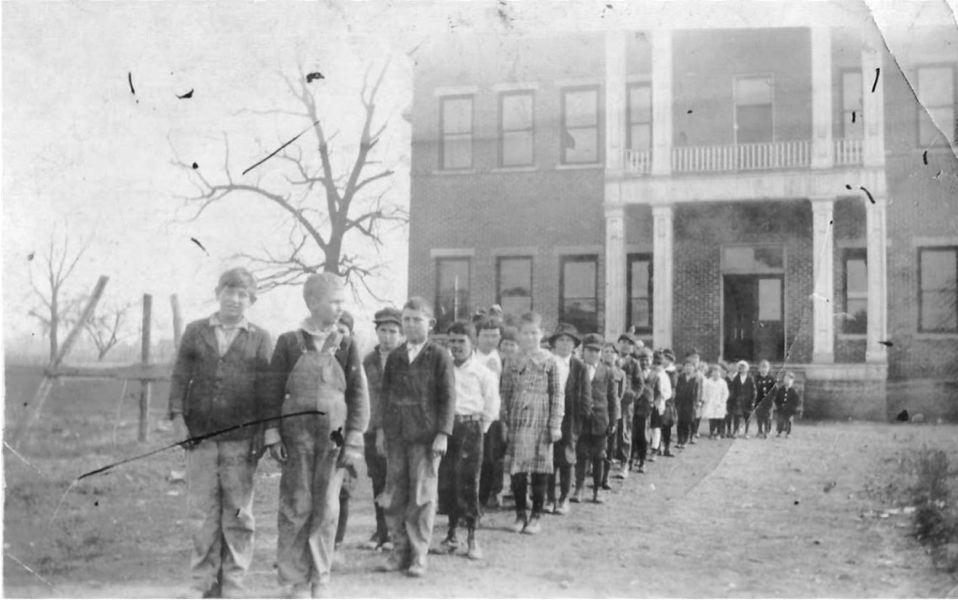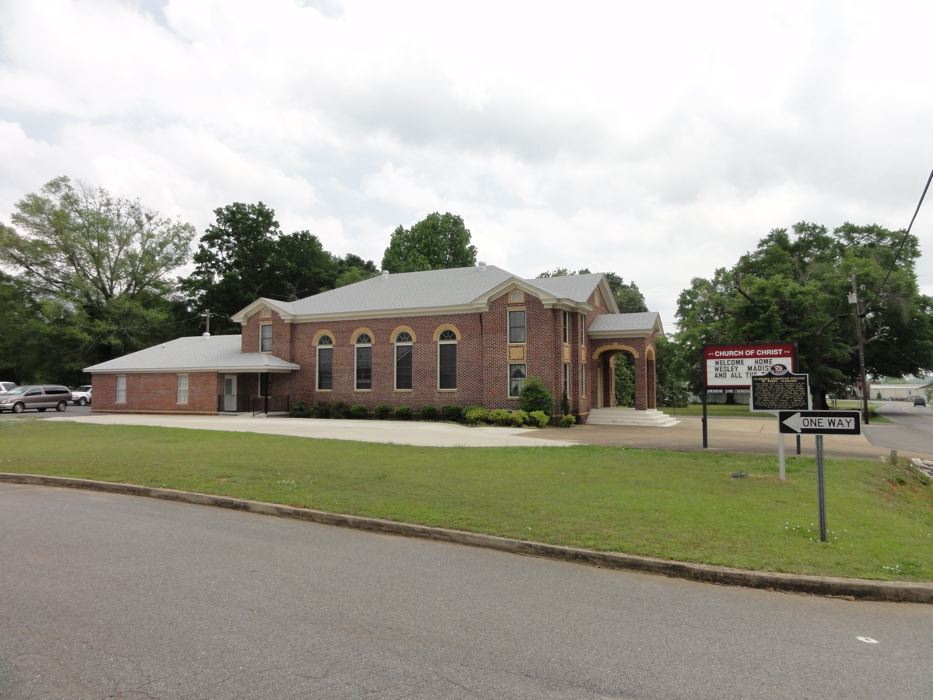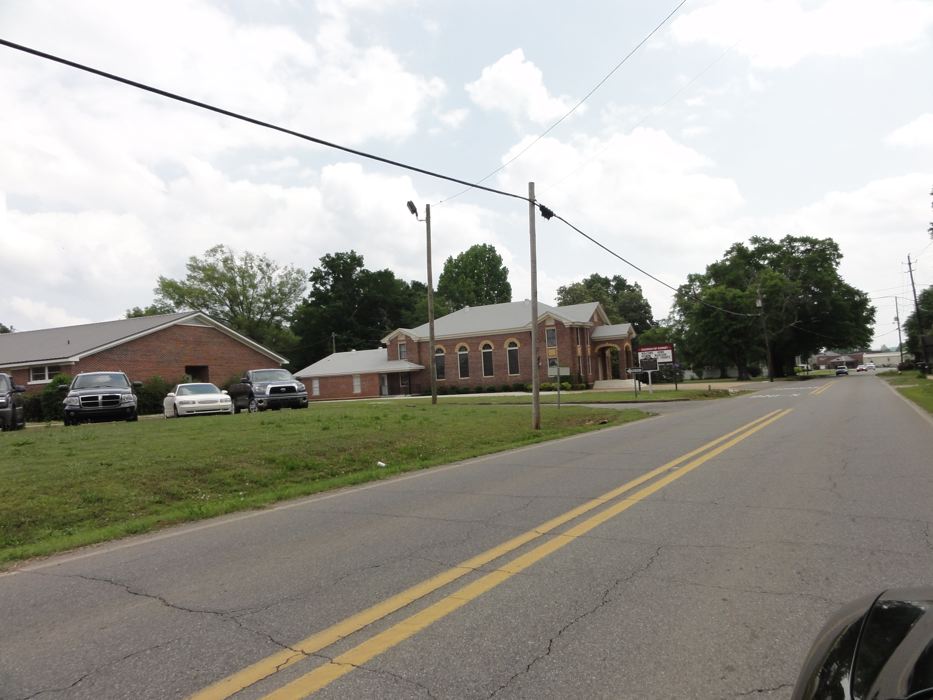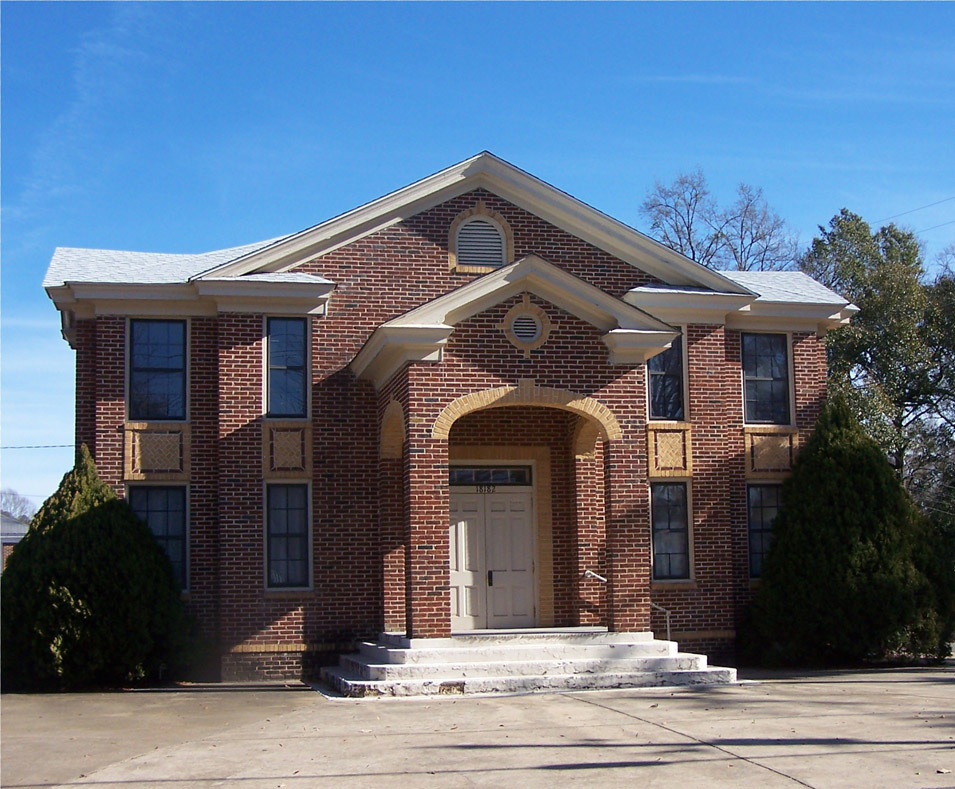Alabama Christian College
Berry, Alabama
1912-1922
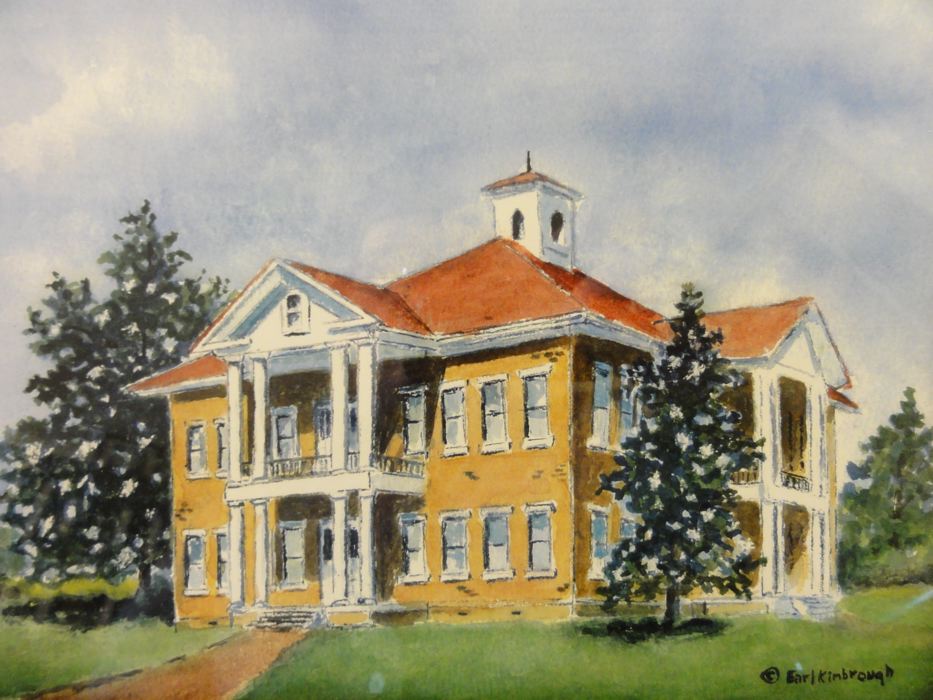
Artist rendition of the old Alabama Christian College building in Berry, Alabama
Artist: Earl Kimbrough
![]()
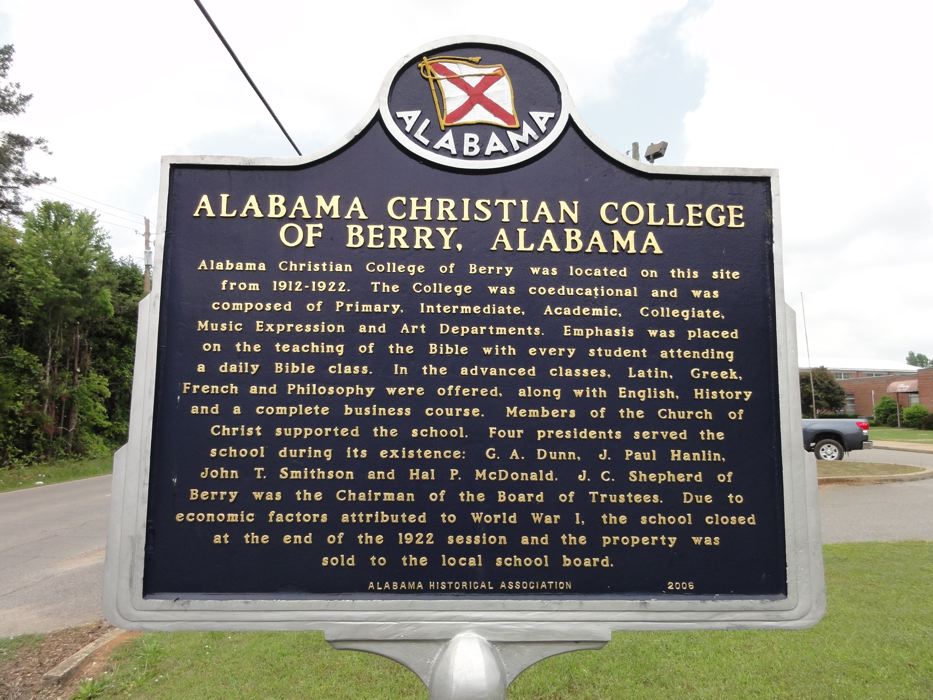
![]()
Alabama Christian College At Berry
Berry, Alabama 1912-1922 A Special Event In 2007
"Mayor Dobbs, Brother Berry, and respected brethren and friends. We are remembering today a little country school that may very well have been forgotten as hardly more than a bump in the history of Fayette County had it not been for one very significant fact: that little school had a large and enduring impact on New Testament Christianity in Northwest Alabama and beyond. This came about through the individuals that the school drew to this part of the state as teachers and administrators, and through the men and women of the area who were educated there. Due to the fruitful labors of these good people, the school's influence continues to resonate even today among the rugged hills and winding hollows of this hall owed region that so many of us are pleased to call home.
While the Alabama Christian College of Berry, Alabama, flourished for only a little more than decade in the early years of the twentieth century, its Christian roots reached back almost a hundred years before to pioneer days; to a time when settlers along the Atlantic Seaboard, many first and second generation Americans, were pushing westward in what came to be known as the nation's Manifest Destiny.
Many of these early Americans migrated to Northwest Alabama from Virginia, the Carolinas, Tennessee, and Georgia, about the time the territory was opened for settlement. Some of these stayed only for a short time and then moved on to Texas, Arkansas, and Oklahoma. But many others took root in the rocky soil of Northwest Alabama to carve out for themselves a distinctive lifestyle that was rural in nature and home and family centered. One young couple who came to this region from South Carolina in 1827, was John and Mary (Polly) Taylor, who settled in what was then part of Marion County along the Sipsey River, near Glen Allen. Mary was nineteen and John twenty at the time. He could neither read nor write when they married, but with the New Testament as their text, Mary taught him to read, and to write.
John Taylor showed little interest in religion until he married, but soon after coming to Alabama, Mary urged him to seek salvation in the Calvinist style of that day. But his efforts to get the promised assurance of salvation at the mourners' bench met with utter failure. He despondently concluded that he was among the non-elect with no hope of redemption; and so, like many foolish ones of that day, and since, he sought to drown his inconsolable grief in alcohol. But when revival time came around the next year, Mary again pleaded, with many tears, for him to give up his jug and make another attempt at being saved. He finally agreed to try again and when the revival began in his community, he and Mary were at the meetinghouse early and took a front seat. As the preacher was preaching, he happened to quote Acts 2:38, where Peter told those sinners who had crucified Jesus to repent and be baptized for the remission of sins.
In recalling the occasion, Taylor said he reflected on the passage for a while and it dawned on him that if those Jews who crucified the Lord could be saved by repentance and baptism, then he could be, too. He said this truth became so plain to him that he began to clap his hands and shout, "Glory to God." The preacher, who knew about John's anguished concern for his soul, stopped preaching and said: "Thank God, John Taylor has got religion at last!" Taylor said he was embarrassed by this, and replied: "No, I have not got it; I only see how to get it. I see exactly what to do for the remission of sins." But it was with considerable difficulty that he finally persuaded a neighborhood preacher to baptize him and his wife upon a simple confession of faith in Christ for the remission of sins.
There was no church of Christ in that whole country and, in fact, John Taylor had never heard of one outside of the New Testament. He knew nothing of the Restoration preaching of Barton W. Stone and Alexander Campbell; nor of the pioneering work of Ephraim D. Moore, James E. Matthews, B. F. Hall, and Elisha Randolph up in Lauderdale and Morgan Counties. So he joined a nearby church and soon began to preach for it. But instead of preaching the creed of that church, he preached only what he found in the New Testament. For that, the church tried him for heresy, turned out of the church, and took away his license to preach. At the time, he had an appointment to preach just over in Fayette County, and although his license had been revoked and he was in a quandary as to whether to keep it, his brother in the flesh, Mark Taylor, encouraged him to do so. He said: "John, if you were able to preach before, you are still able." So he kept the appointment and preached on, "What Must I Do to Be Saved."
Time will not now permit us telling the thrilling story of how that preaching appointment led to the beginning of the first church of Christ in this whole region. This was in 1829-1830. The church he established consisted of about thirty members, all of whom John Taylor had baptized for the remission of sins within a month after his preaching license was revoked.
Thus, John Taylor began, right here in Fayette County, an independent church that was completely unique in that it had no connection whatever with any other undenominational Christians anywhere. However, within a year of the church's beginning, the families of Robert Logan and Hugh White McCaleb, and a little later, Elisha Randolph, moved to the county. These were already Christians when they came here from Morgan County and with their help the church, now known as Old Berea, was established in the faith. This was the beginning of apostolic Christianity in Marion and Fayette Counties.
From that faithful congregation and the able pioneer preachers who were among its membership, literally thousands of people obeyed the gospel just as those sinners did on Pentecost, and simple churches of Christ were soon established in most communities of Northwest Alabama. Among the area preachers before the Civil War were John Taylor, Elisha Randolph, and his sons Jeremiah, Lorenzo Dow, and Simeon, together with Carroll and Allen Kendrick, William Stringer, and others.
This, in brief, is the background of the churches of Christ in this part of Northwest Alabama. It was from the descendants of these pioneer Christians that the move was made in the early part of the last century to build a school at Berry, Alabama, so their children could receive an education in a Christian environment, free from worldly influences and sectarian biases. Many of these descended from people who, like John Taylor, laboriously learned at home to read and write, and came to appreciate the value of an education. Many of them wanted to make sure that their children not only could read and write, but that they could be educated by Christian teachers in a righteous environment. T. B. Larimore had operated Mars' Hill Academy on Christian principles near Florence from 1871 to 1887, but he had closed it to give him more time for evangelistic work. J. M. Barnes also operated schools with Christian teachers south of Montgomery, beginning with Strata Academy in 1856, soon after he graduated from Bethany College. It continued as Highland Home Institute until 1916, but that school was of little practical use to the Christians of Northwest Alabama because of the distance and expense involved in sending their children there. So in about 1911, John T. Lewis, O. C. Dobbs, J. C. Shepherd, and others took the lead in establishing a college with emphasis on the Bible to be located in the town of Berry.
Asa M. Plyler, in his Historical Sketches of Churches of Christ in Alabama, written in the early 1940s, referred to Berry as "another splendid little town" in Fayette County. Concerning the Berry church, he said: "This congregation has been known through the length and breadth of the land in times past. This was the home of the Alabama Christian College [that] did a fine work in Bible, business training and the literary branches for about ten years. A number of gospel preachers were trained in this school, and much and lasting good was accomplished by this school while it was in progress. I understand that the greater part of the money to build the school was furnished by one man who was a member of the Berry congregation ... J. C. Shepherd. Among those who held meetings for the church there are such men as Joe S. Warlick, J. D. Tant, G. A. Dunn, Foy E. Wallace, Jr., and L. R. Wilson and many other leading evangelists." Plyler concludes by saying: "We have known some very fIne people in the church [at Berry], among the number are the Shepherds, Baileys, Shooks, Clements and Dobbs, and a host of others." (Asa M. Plyler, Historical Sketches, 7, 8.)
The Alabama Christian College of Berry was founded in June 1912, with J. C. Shepherd, John Tomlin, M. P. Bailey, and O. C. Dobbs as Trustees. Shepherd was a banker and a leading business man in Berry and O. C. Dobbs was a well known gospel preacher throughout Northwest Alabama. G. A. Dunn, Sr., a well known Texas preacher came to Berry to serve as the school's first president. He served the school three years and brought to the community such outstanding preachers as J. B. Nelson and Frank Baker. The girl's dormitory was a large white two-story building on the north side of the campus. Boys were boarded in private homes; the cost ranging between eleven and fifteen dollars a month. Tuition ranged from twelve to twenty dollars for each term, depending on the department. A few years ago, Enloe Billingsley. who was reared in Lamar Country, moved to Sun City Center, Florida, and he and his wife, Marie, became identified with the East Bay church, where I preach. In visiting, we often talked about Alabama, and one day I said something about the old college at Berry, and he told me, very proudly, that his mother boarded boys who attended the school. Enloe, who died last March at 94, had deep roots in Northwest Alabama. He was a cousin of Price Billingsley and a great-great-grandson of Elisha Randolph. Randolph had a large family of nine boys and one girl. Enloe's great-grandmother was Elisha's only daughter, Anna Mariah, who married Jeptha Billingsley prior to 1832. If that were not enough preachers in his family, we might add that Enloe's mother was Lucretia Black, a devout Christian in another family of Fayette County preachers, including V. P. Black.
The college building was located where the Berry High School now stands. It was a two-story beige brick building with four classrooms on the first floor and wide cross halls leading to the entrance doors at each end. Two winding staircases led to the large upstairs auditorium. Two more classrooms were located at the rear of the auditorium. Larry Whitehead says: "A unique, sweet tolling bell weighing 2,400 pounds rang daily and could be heard for miles around. The bell was a gift of 'Grandma' Shepherd and was in use until the building burned in 1933." (Alabama Restoration Journal, Nov. 2005.)
J. Paul Hanlin of Sheffield served one year as president of the college following Gus Dunn. Writing about the school that year, he spoke of himself and John T. Smithson, of Fort Deposit, Alabama, as working with the school. Both had been students of David Lipscomb at the Nashville Bible School. Hanlin noted that Hal P. McDonald, another Texas preacher, was chosen to serve as president in 1916. McDonald's tenure continued until the school closed in 1922. Whitehead writes of him: "He was known as an excellent teacher although somewhat eccentric. [He] introduced the concept of an annual lectureship after he took the reins in 1916. Each year prominent preachers from over the country were invited to present lessons during the lectureship and the general public was invited. Such men as J. C. McQuiddy, C. M. Pullias, E. A. Elam, John T. Lewis, and J. D. Tant were invited among many others." (Ibid.) The Alabama Christian College of Berry further influenced the area in that many of those who came to teach regularly and to participate in lectureships, left an impression for good on the region. Gus Dunn returned to Northwest Alabama every year for gospel meetings as long as he lived, baptizing hundreds of people. J. D. Tant frequently preached in the state in the early years of the twentieth century. McDonald himself spent the rest of his life in the area. Other notable preachers also came to the state originally because of the school. L. R. Wilson, who lectured at the school and served for a time as minister of the Berry church, influenced my life for good. I had the privilege of profitably sitting at his feet for two years.
Perhaps the greatest influence of the Berry school was that made on the students. Gus Nichols, was without doubt the most successful and influential man who attended the school during its existence. Flavil Nichols, who is with us today, says his father baptized more than 12,000 souls. Angie Logan Thompson from Russellville, whose younger sisters, Lavaga and Hilda Jean Logan are also here today, attended the college in its heyday. Leo and Brody Plyler, sons of Asa M. Plyler, another student at the Berry College, are in the audience, along with forty or fifty others who are related to students of the school. The Logan sisters are descendants of Robert Logan, one of the early members of the Old Berea Church. They also have the honor of being my cousins. So that makes me kin to a family of a student of Alabama Christian College of Berry.
We are pleased today with the beautiful marker that has been erected by the State of Alabama near the street and between the meeting house of the Berry Church of Christ and the property that was the site of the Alabama Christian College, both near the home of the school's benefactor J. C. Shepherd. This grand memorial no doubt will be telling the story of the old Berry College a hundred years from now, when we will be sleeping in the earth. We are grateful for the opportunity to have had a part in the services today celebrating the erection of the monument.
Thank each of you for the interest you have shown in the Alabama Christian College of Berry by your presence today."
-Earl Kimbrough, Alabama Restoration Journal, Vol 2, No. 1, Feb. 1, 2007, pages 23-25
![]()
Alabama Christian College Established At Berry
Alabama Christian College, Berry Alabama -- The following is quoted from an article by Mr. Hal P. McDonald.
"The original and first Alabama Christian College was promoted, founded and opened for work in 1912. The school was conceived, financed and built by members of the Church of Christ and friends of the Christian Education in the section of Alabama that the Bible might have prime place in the educational and practical life of the school.
This school was located on a choice eight acre campus in the very heart of the little town of Berry, the Beautiful. Berry is midway between Birmingham and Columbus, Miss., and about sixty miles from either, on the Southern Railway, at which time there were four passenger trains daily. Berry is the highest opine between these two fine cities, flanked by the foothills of the Great Appalachians Mountain System, overlooking the greatest mineral and mining region of the great and beautiful South land. Near the center of this eight acre campus stood the two-story, brick veneer college building with it unique, sweet tolling bell of some 3,300 pounds weight, the give of Grandma Shepherd."
Trustees of the Alabama Christian College were--J.C. Shepherd, John Tomlin, Mose P. Bailey, and O.C. Dobb.
The school was taken over by the Berry High School in 1921.
Berry Church of Christ
The Berrry Church of Christ started in the store of Mrs. Oliver C. "Granny" Dobbs in the early 1900's. The Church was officially organized in 1911 and some of the charter members were Mrs. Oliver Dobbs, J.R. Dobbs, J.R. Dobbs, O.C. Dobbs, J.D. Dobbs, Sam Dobbs, Mr. and Mrs. Cap Sheperd, Mrs. C.H. Pinion, Mr. and Mrs. Coger Sheperd, Mrs. Cardie Stewart, Mr. and Mrs. Mose Bailey, Mr. Lump Smith, Mr. B. Johnson and Mr. and Mrs. Fenton Anthony.
A partial list of the preachers gives the following men: Charlie Wheeler, Frank Baker, O.C. Dobbs, G.A. Dunn, J.B. Nelson and Gus Nichols.
The Church of Christ is still meeting in Berry close to the High School. There are 85 members on roll at the present time. The Church meets each Sunday and Sunday night, Tuesday afternoon and Wednesday night. There are classes for all ages.
-Sesquicentennial Broadcast, Sept. 1969, page 28
![]()
School Days At Alabama Christian College, Berry, Alabama
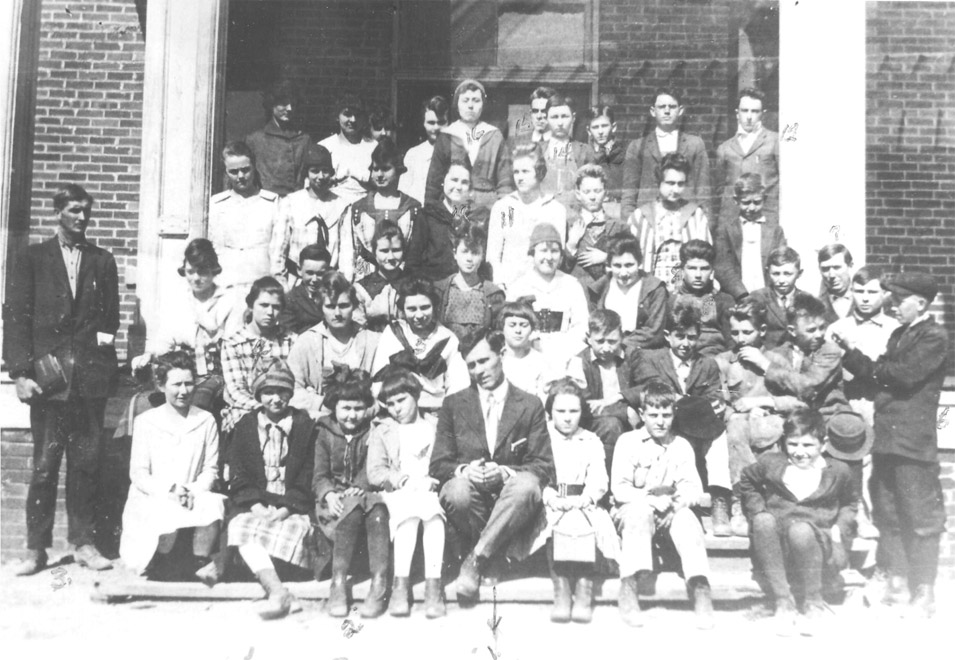
Students With Hal P. McDonald In Front-Center
![]()
Work At Berry
Recently I spent fifteen days in preaching the gospel of Christ at Berry, Ala., and in trying to put the school there on a sound basis. As a result of my preaching, one who had wandered from God came home and eleven were baptized. During the meeting Brethren I. B. Bradley, of Birmingham, and T. B. Thompson, of Huntsville, assisted much by their presence and encouragement.
For the benefit of the school I made the following suggestions, which were indorsed by all: (1) That the name “Christian College” be not used, as the name “Christian,” when applied to a school, carries the same sectarian meaning that the word “Baptist” or “Methodist” would carry. (2) That the idea of the school as a church school or a religious institution be discarded, as the church of Christ is the only religious institution that God knows anything about. (3) That the brethren make a claim for their part of the free-school money, which they can get when it is known that they are not running a church school, or denominational school. (4) That a room be reserved in which a regular course in Bible study can be given to any boy or girl who may desire to study the Bible, but that they do not make Bible study compulsory. (5) That Brother [J. C.] Shepherd cancel his sixteen-thousand-dollar mortgage against the house and ground, provided the church and people here will build a good dormitory that will care for fifty students. Brother Shepherd seemed anxious to make this gift, and the brethren are going to work to complete the dormitory by September. (6) That the church get some school man who is able to carry all at least two years in college work beyond the high school, and have associated with him three good teaches, so that we can have a four-teacher school who can manage two hundred students in their work here. The school will have State affiliation for all work done. (7) That they get out at least five thousand catalogues stating their work and put them in every church and school community in Alabama. (8) That they put some man in the field to visit every congregation in Alabama and get individual pledges to raise from fifty thousand to one hundred thousand dollars as an endowment to support not only a Bible teacher in the school, but help support first-class teachers, so we can soon give a nine-months’ school each year to all who may desire to come.
All these suggestions were readily accepted, and the church at Berry is now looking for a school man who has been a success in the schoolroom and who is able to do the work. Application should be made to J. C. Shepherd or A. B. Tenney, who are now teaching the school.
Work at Berry, Ala. By J. D. Tant, Gospel Advocate, Vol. 64, No. 12 (March 23, 1922): 285
![]()
The Bible College at Berry, Ala
Quite a number are asking me about “our Bible college” at Berry, Ala. I will state that it is a thing of the past. At the time of my last meeting there, Brother Shepherd agreed to cancel his sixteen-thousand-dollar mortgage against the school property, provided the church would build a dormitory. An outsider promised to give the lumber with which to build it, if the church would cut and haul the logs to the sawmill, but the church was not interested enough to do so. Brother Shepherd has sold the house to the town for a high-school building, which, I am sure, is the best he could do.
With a fine school building at Henderson, Tenn., and also one at Nashville, Tenn., with the best teachers and equipments, there was no need of a Bible college at Berry.
But Berry is not the only little town that has made the same sad mistake, and many brethren have lost all they had by breaking up and moving to the school. Lockney, Denton, Cleburne, and Sabinal, Texas; Odessa, Mo.: and Rector, Ark., can tell the same sad tale. Thousands of dollars were lost in building schoolhouses, and many went school crazy and worked harder to build up “our Bible college” than they did to build up the church of Christ.
In fact, I sometimes doubt if our so-called “Bible colleges” have ever been any benefit to the upbuilding of Christianity. A very large per cent who come out of our Bible colleges come out as professionals, hunting to “take charge” of some church and set the eldership aside, and fill the place of a modern sectarian pastor.
If our Bible college is God’s ordained institution, instead of the church, to make gospel preachers, why not start one to make scriptural elders? I am sure the greatest hindrance we have to-day is the inefficient eldership. Eight out of ten who act as elders have the work forced upon them by the church. They declare they do not want it, and Paul says they must desire the office. Many of them have neither time nor inclination to prepare the food to give to the church of God, as Paul instructed them in Acts 20:28. They give out so many tin cans, raw bones, and so much spoiled meat that a goat would starve upon such feed. They claim they do not have time to do this work and must hire a pastor to do it; yet, if the eldership of the church of Christ carried a salary of five dollars a day, three-fourths of all men and two-thirds of all women who are added to the church would qualify themselves and want to be elders. Brethren, let us think seriously of the service we offer to God.
By J. D. Tant, Gospel Advocate, Vol. 64, No. 26 (June 29, 1922): 621
![]()
Gus Nichols Home At Berry, Alabama
At the unveiling of an Alabama state marker at Berry, Alabama, October 15, 2006, in memory of the Alabama Christian College that flourished there 1912-1922, I had an extended and pleasant visit with Flavil Nichols, son of the noted Alabama evangelist, Gus Nichols. The elder Nichols was a student at the old college and lived in Berry in the days of the school's existence. Flavil pointed out a lane that ran between the picturesque meeting house of the Berry church of Christ and the stately home of J. C. Shepherd, who had financed the building of the school almost a hundred years ago.
Flavil said down that road a short ways, his father used a horse drawn scoop to level a hill in preparation for the building of a house for Frank Baker, a prominent teacher at the Berry college. Flavil said his father then scooped a level place on a neighboring hill where he built a house for his own family. In building the house, Flavil said his father used rough lumber that came from the sawmill in unplaned style. Someone advised him that creosote would preserve the wood and so the resourceful preacher generously coated his house with creosote, which naturally soaked well into the rough unpainted boards, turning them dark brown.
Creosote is made of distilled coal tar and has an odor that is far from pleasing. Flavil remembered that the odor of the creosote was so bad the family could hardly stand it. I asked him how long the odor remained and he said as long as the family lived there, but he did not say how long that was. I did not ask him if his father covered the house inside and out with creosote, as Noah did the ark with pitch. Nothing is said about the odor of Noah's pitch, but John Wesley thought the pitch coating outside the ark served to shed the water and that inside the ark was "to take away the ill smell of the beasts kept close." If Gus Nichols' creosoted house provided any benefit for his family, other than the "fond" memory of the aromatic ordeal it put the Nichols' family through, Flavil did not mention it.
-Earl Kimbrough, Alabama Restoration Journal, vol. 2, no.1, page 22
![]()
Present Day Photos Around The Old College Grounds
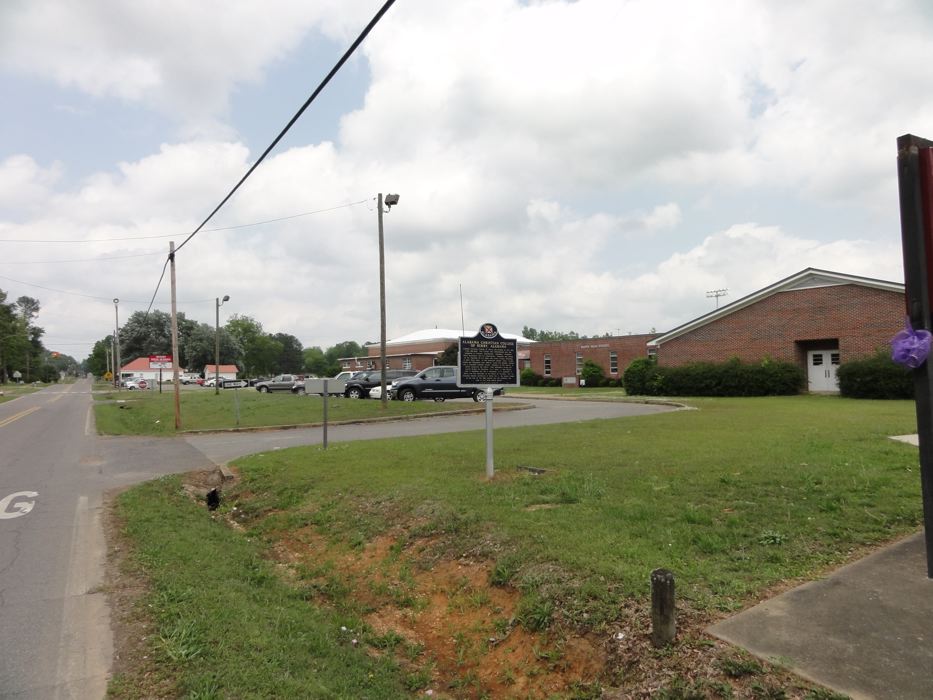
Present Day High School Behind Historical Marker Is The Location Of The Old College
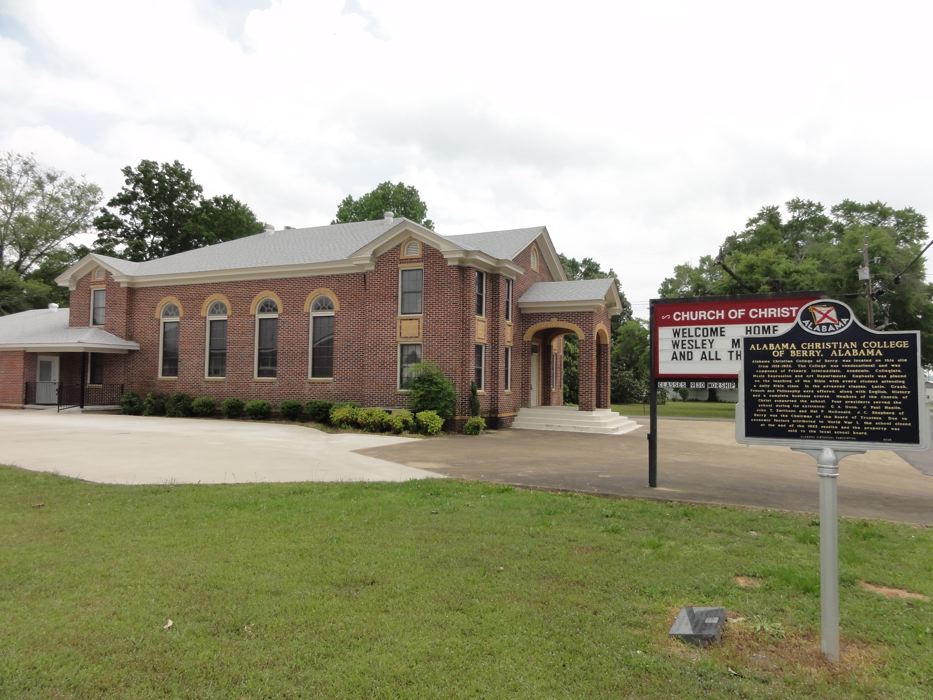
Berry Church of Christ To South Of The Old College Grounds
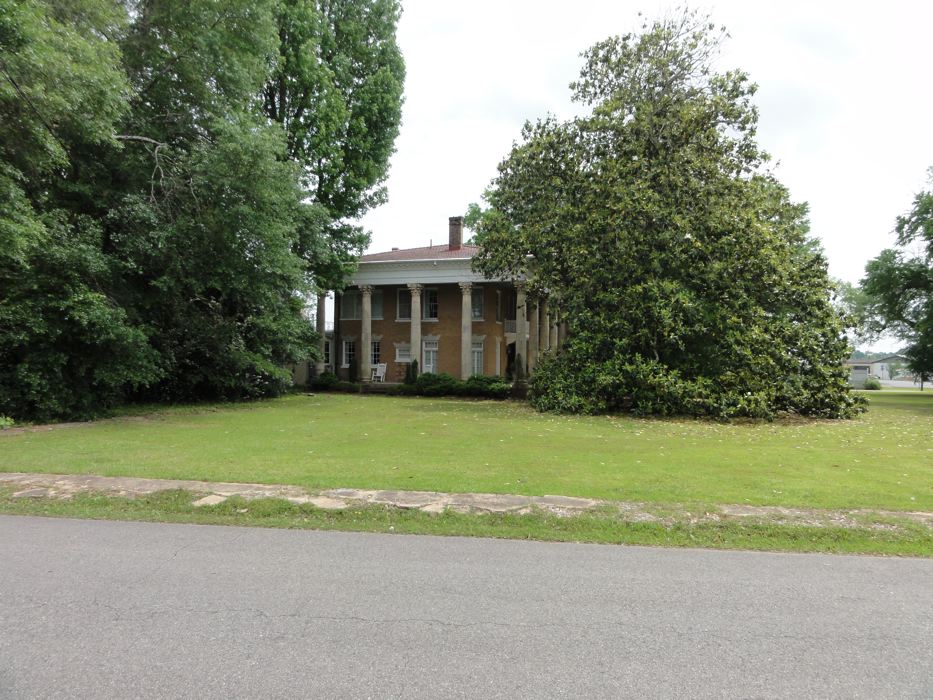
J.C. Sheperd Home, Berry, Alabama
Across Street, Just South of the Church Building
![]()
GPS Location Of School & Berry Church of Christ
33°39'46.5"N 87°35'57.5"W
33.662928, -87.599294
![]()
Special Thanks
Much effort from so many has gone into the production of this site. Gleanings from works of the past have been added, not just to show the history of the event of this school, but controversy surrounding it. Thanks to C. Wayne Kilpatrick for locating information, and photos that were added here. Also, special thanks to Larry Whitehead of the Alabama Restoration Journal and Earl Kimbrough for the wonderful piece on the addition of the historical marker in 2007.
![]()
